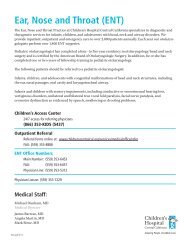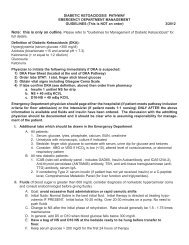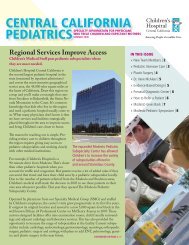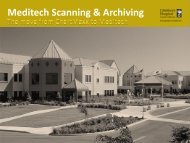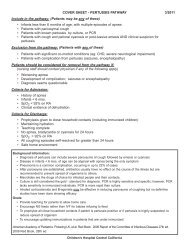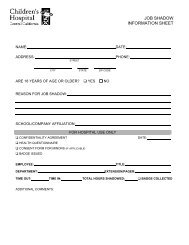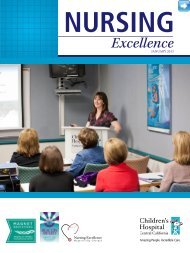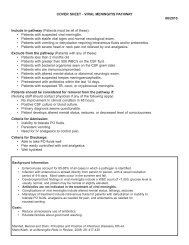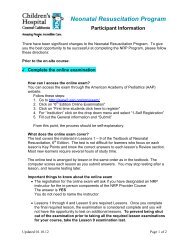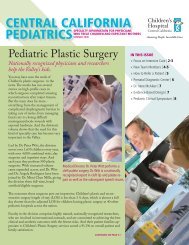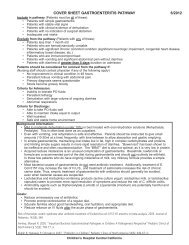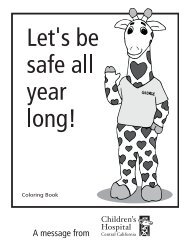Possibilities - Children's Hospital Central California
Possibilities - Children's Hospital Central California
Possibilities - Children's Hospital Central California
You also want an ePaper? Increase the reach of your titles
YUMPU automatically turns print PDFs into web optimized ePapers that Google loves.
Each operation more painstaking thanthe last, cardiologists and cardiothoracicsurgeons at The Jane Seddon WillsonHeart Center at Children’s <strong>Hospital</strong> <strong>Central</strong><strong>California</strong> carefully fixed Seth DeSantis’heart, not once, but several times.Less than a year old, his pediatrician detected amurmur in his heart and recommended the familysee a specialist at Children’s <strong>Hospital</strong>.Children’s cardiologist James Prochazka, M.D.,confirmed that Seth had a membrane obstructingthe flow of blood in his tiny heart.“We knew we had to repair it. The membrane wascausing his heart to work harder,” says Dr. Prochazka.“There can be difficulty with the surgery because themain nerve that supplies the impulse for the bottomchamber of the heart to contract is right there,”explains Dr. Prochazka. “Another problem is thatdespite our best efforts, this membrane can recur.”Initially the tiny tot did very well. Dr. Prochazkaperformed careful follow-up and noticed therecurrence of the membrane blockage, plus thepatient’s valve was beginning to show some leakage.In April 2001, Dr. Petrossian and Frank Hanley, M.D.,performed a repeat operation. Doctors knew it wouldbe a delicate surgery.Because of the intricate work that had been donearound the heart nerves, cardiologists decided to put ina pacemaker as a backup a couple of years later.Never Missing a BeatThe Players: Doctors James Prochazka, Frank Hanley, Edwin Petrossian and The Jane Seddon Willson Heart Center at Children’s“This membrane creates turbulence that could destroyhis delicate aortic valve over time. If left untreated, hewould need valve replacement later in life.”“When Seth was first diagnosed, we were in shock,”says his mom, Julie. “We weren’t expecting that. Wewere told Seth needed surgery.”Children’s board-certified cardiothoracic surgeonEdwin Petrossian, M.D., performed the first of severalprocedures on Seth at the <strong>Hospital</strong> in February 1999.He carved out the membrane that was obstructing theblood flow in the young patient’s heart.Ultimately, Seth had an additional surgery performedthe following year to stop the leakage developing inhis aortic valve.“We’ve prevented a lot of damage that will pay off witha full and healthy life for Seth,” says Dr. Prochazka.Survival rates for Children’s cardiac patients are amongthe highest in the nation.“They don’t send you home until you’re better,” saysMom. “You go home healed.”Now, the third grade Century Elementary Schoolstudent never misses a beat. When he’s not havingsibling rivalry with his sisters Emily, 11, andVanessa, 14, he’s on the green practicing to be thenext world-class golfer.And he’s no hack. The 9-year-old’s pacemaker wascarefully placed so he could still swing the iron. “He’sgoing to be a great golfer,” adds Dr. Prochazka, one ofSeth’s biggest fans.Dr. Prochazka and the Heart Center team keep pacewith Seth through regular visits at The Jane SeddonWillson Heart Center at Children’s.Sponsored by“He’s one of our heroes,” exclaims Dr. Prochazka. “Heseems to face his adversity with a lot of courage.”Just as Seth plays to win on the golf course, so does thecardiology team when it comes to healing kids.



